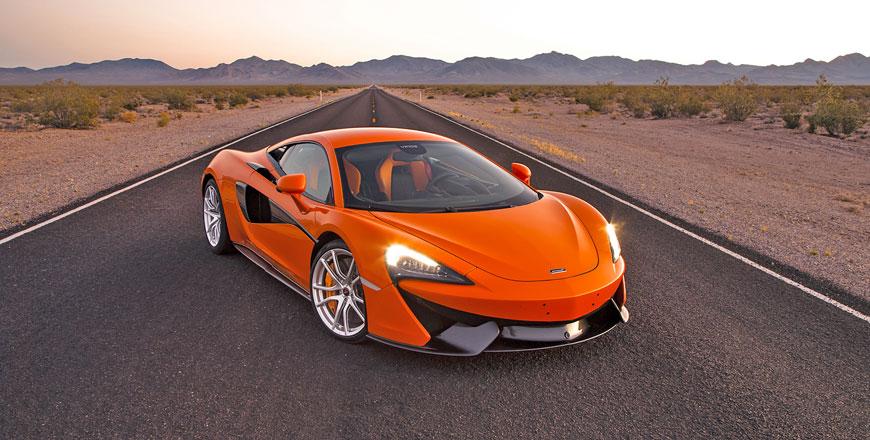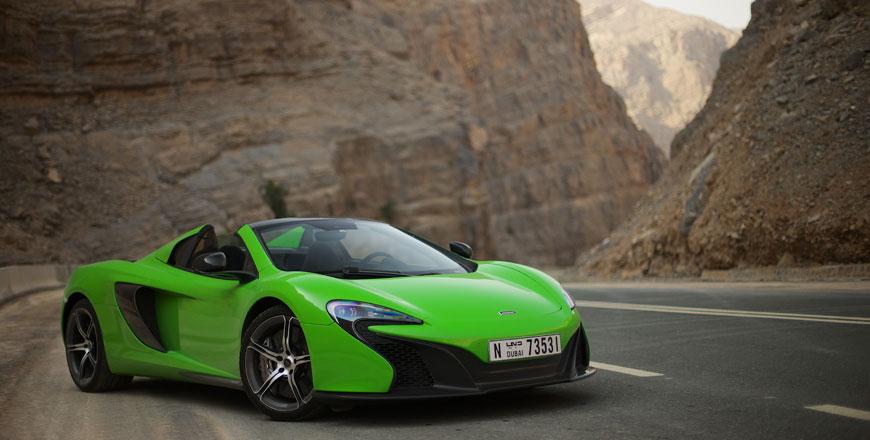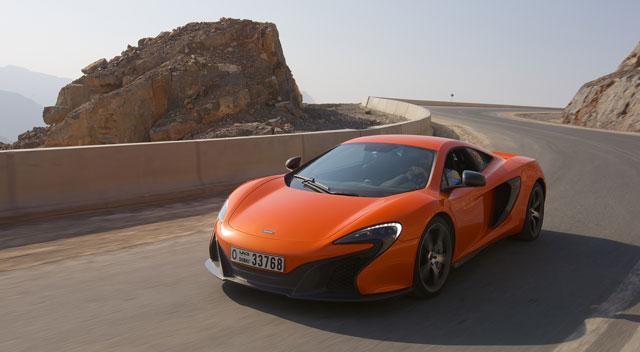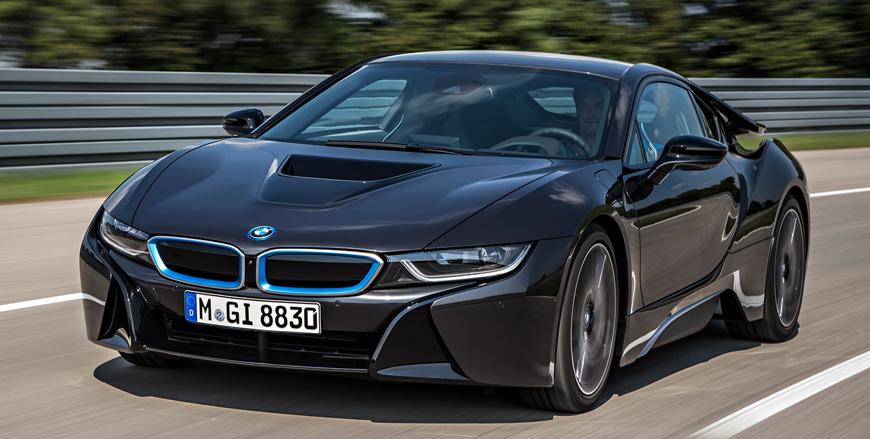You are here
McLaren 570S Coupe: Practical performance and precision
By Ghaith Madadha - Jun 27,2016 - Last updated at Jun 27,2016

Photo courtesy of McLaren
The first in British super car manufacturer McLaren’s expanded entry-level Sports Series cars, the 570S is a more affordable offering slated as sports car rather than the brand’s supercar Super Series cars. Built around the same lightweight frame, platform and drive-line as the core “super” 650S model, the 570S little differs in size and weight or even performance, but is a more practical and accessible car.
Taking a more “back-to-basics” approach for a brand so heavily steeped in high-tech solutions, the McLaren 570S ditches costly and complex technologies such as the 650S hydraulic suspension and active aerodynamics. Slightly lighter with more steering feedback, improved cabin access, ergonomics, visibility and luggage space, the 570S is the most useable McLaren to date and places a particular emphasis on enhanced craftsmanship and reliability.
Predatory posture
Competing with the Audi R8 and Porsche 911 rather than Lamborghini Huracan and Ferrari 488, the McLaren 570S may lose 79BHP and 57lb/ft torque to its more exotic 650S sister, yet performance is little affected by comparison. Spectacularly swift with 3.2-second 0-100km/h acceleration and 328km/h top speed, the 570S may be pitched as sports car, but it is also hard not to view it as somewhat of a bargain supercar.
Winner of the Middle East Car of the Year annual awards for Best Premium Performance Coupe segment and runner-up to the overall grand MECOTY recognition in 2016, the 570S is the lightest among its competitors by around 150kg and offers the best power-to-weight according to McLaren. Business-wise, it is expected to help raise McLaren’s production from a record 1600 units in 2015 to 4000-4500 unit production capacity.
Built on the same lightweight and stiff carbon-fibre passenger cell, aluminium frames and mid-engine platform, the 570S bears strong familial resemblance to McLaren’s other offerings. Predatory in posture with low slung bonnet, sharp air-splitter and side scoops, the 570S features McLaren’s now trademark sci-fi like headlights reflecting the brand’s emblem. With rising waistline leading to strong haunches, the 570S butterfly-style rear fascia and lights also resemble the McLaren emblem.
Heady thrills
Powered by McLaren’s staple twin-turbocharged 3.8-litre V8 engine detuned to a still scintillating 562BHP delivered a heady 7,400rpm, the 570S performance figures are staggeringly swift, dispatching 0-220km/h in just 9.5 seconds and onto 400 metres from standstill in 10.9 seconds at 220km/h. Meanwhile large fade-resistant carbon-ceramic disc brakes with 6-piston front and 4-piston rear callipers bring the 570S to a halt from 100km/h in 33 metres and from 200km/h in 126 metres.
With mid-engine pressing fat 285/35R20 rear tyres hard into tarmac, the 570S launches vigorously off-the-line, with little by way of turbo lag, before its twin chargers are fully spooled. With stratospheric rev range for a turbocharged engine — and crisply aggressive harmonics — the 570S delivery is eager and long-legged, allowing for precise throttle control and responses, if not quite as sharp as the 650S from idle engine speed.
Producing a muscular 443lb/ft throughout a somewhat high but broadly accessible 5,000-6,500rpm band, the 570S delivers effortless mid-range flexibility, but comes alive with manic urgency as revs rise through its torque plateau and towards peak power. Driving rear wheels through McLaren’s now familiar 7-speed automated dual clutch gearbox, cog shifts are sweetly, swiftly and smoothly executed in auto mode with three escalating response settings or manual shift mode through large fixed steering column-mounted paddle shifters.
Confidence and control
Riding on double wishbone suspension with more conventional adaptive dampers and mechanical anti-roll bars in place of the 650S sophisticated and unique hydraulic system, the 570S may lose some small degree of vertical wheel travel and ultimate fluidity. However, driven on imperfect, narrow, fast and winding British B-roads, the 570S rode best with its adjustable suspension in “comfort” mode, where lumps, bumps and cracks were dispatched with supple fluency.
With suspension settings in “sport” and “track” modes body control becomes tauter and sharper, but on public roads, “comfort” mode serves perfectly well in almost all situations. Neural handling with slight 58 per cent within wheelbase rear weight bias the 570S corners with athletic grace and agility, pouncing with poise and precision through successive corners over a sprawling and textured landscape. Electronic stability controls feature an independent “dynamic” mode for greater handling autonomy before electronic intervention.
Agility and precision is further enhanced by a Brake Steer system that selectively brakes the inside rear wheel to tighten entry into an apex, allowing for later braking and earlier throttle on exiting. Meanwhile, the 570S steering is quick, precise, refined and delivers textured feedback for road and position. Steering with confidence and a feeling of control with quick wrist flicks, the 570S tucks alert and crisp into corners yet remains reassuring at speed.
Ergonomic and spacious
More closely resembling its P1 hyper car Ultimate Series stablemate rather than the 650S, the 570S, however, lacks both models’ active aerodynamic system. It instead uses fixed aerodynamics, including shrink-wrap design, side intakes, front aero blades, integrated spoiler and rear diffuser to manage airflow around and over the car smoothly while providing downforce and high-speed stability, as well as sufficient cooling and heat extraction to the mid-positioned engine bay.
With longer and wider cabin, repositioned A- and slimmer B-pillars, the 570S cabin is more spacious and ergonomic and benefits from a revised cabin design incorporating a floating console sans centre stack division. Wider opening butterfly doors and lower and slimmer sills make access into the 570S easier than the 650S, even for larger occupants, while optional electric seats are highly adjustable, supportive and remain comfortable over long periods.
With a focused and alert driving position, big windscreen, terrific visibility and wing scallops peaking over the wheel centres, one can precisely and intuitively place the 570S through narrow winding roads with confidence to match the agility of its chassis. Focused and ergonomic, the 570S cabin features logical, tactile and user-friendly controls, dials and infotainment screen combined with airy ambiance, quality materials and improved stowage space.
TECHNICAL SPECIFICATIONS
Engine: 3.8-litre, mid-mounted, all-aluminium, dry sump, twin turbo V8 cylinders
Valve-train: 32-valve, DOHC, continuously variable valve timing
Bore x stroke: 93 x 69.9mm
Gearbox: 7-speed automated sequential dual clutch, RWD
Power, BHP (PS) [kW]: 562 (570) [419] @7,400rpm
Specific power: 147.9BHP/litre
Power-to-weight: 428BHP/tonne
Torque, lb/ft (Nm): 443 (600) @5,000-6,500rpm
Specific torque : 158Nm/litre
Torque-to-weight: 457Nm/tonne
Rev limit: 8500rpm
0-100km/h: 3.2 seconds
0-200km/h: 9.5 seconds
0-400-metres: 10.9 seconds @220km/h
Top speed: 328km/h
Fuel consumption, combined: 10.7l/100km
CO2 emissions, combined: 249g/km
Structure: Carbon fibre monocell, aluminium front & rear frames
Length: 4,530mm
Width: 2,095mm
Height: 1,202mm
Wheelbase: 2,670mm
Dry weight: 1,313kg
Weight distribution F/R: 42:58 per cent
Steering: Power-assisted rack and pinion
Suspension: Double wishbones, coil springs, adaptive dampers, antiroll bars
Brakes, F/R: Carbon ceramic discs, aluminium hubs, 394 x 36mm/380 x 34mm
Brake callipers, F/R: 6/4 pistons
100-0km/h: 33 metres
200-0km/h: 126 metres
Tyres, F/R: 225/35R19/285/35R20
Related Articles
Succeeding the McLaren 12C super car it was meant to complement owing to popular demand, the 650S is based on the same basic chassis, suspen
Initially intended to complement the McLaren 12C as a sharper, more focused and powerful supercar bridging the gap to the brand’s P1 hybrid hypercar, the 650S has, however, come to replace the 12C — as some speculated — owing to overwhelming customer preference for the newer car.
The first mid-engine BMW since the M1 sports car of 1978, the BMW i8 was first glimpsed as the Vision Efficient Dynamics concept in 2009, be



















